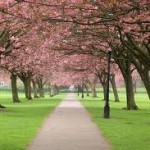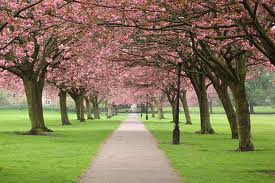 [Trees near you] Today, Rosh Chodesh Nissan, is the firstday to recite Birchas Ha’ilanos. Click here for a list of locations around Lakewood where the Bracha can be recited. The Bracha to recite on the budding fruit tree is : “Baruch ata Hashem Elokeinu melech haolam shelo chisar ba’olamo klum, uvara vo beriyos tovos v’ilanos tovim lehanos bahem b’nei adam.”
[Trees near you] Today, Rosh Chodesh Nissan, is the firstday to recite Birchas Ha’ilanos. Click here for a list of locations around Lakewood where the Bracha can be recited. The Bracha to recite on the budding fruit tree is : “Baruch ata Hashem Elokeinu melech haolam shelo chisar ba’olamo klum, uvara vo beriyos tovos v’ilanos tovim lehanos bahem b’nei adam.”
If you know of any other fruit trees where one can recite the Bracha, feel free to list it in the comments section. TLS/Misaskim.


SOME RELEVANT HALACHOS ABOUT BIRCHOS HAILANOS L’TOELES HARABIM , COPIED WITH PERMISSION FROM http://WWW.HALACHAFORTODAY.COM
1) One who sees fruit trees that are beginning to bloom, in the [beginning of the] month of Nissan, or at any other time when it’s the season for the trees to bloom, recites the following Bracha: Baruch Ata Hashem Elokeinu Melech HaOlam Shelo Chisar B’Olamo Klum U’Vara Vo Beriyos Tovos V’Ilanos Tovos (or “Tovim”; See Kitzur Shulchan Aruch Siman 60:1) Lehanos Bahem Bnei Adam- Blessed are You Hashem, Our G-d, Master of the Universe, who ensured that nothing is lacking in His world and Created in it good creations and good trees in order to pleasure mankind with them. (Shulchan Aruch Siman 226:1 and Mishna Berura S”K 1. See also Aishel Avraham Butshatsh that only in Nissan may the Bracha be recited with Shem U’Malchus. However, the prevalent Minhag is to say the regular Bracha as long as the tree is still in the blooming stage, even if this is past Nissan. See Chayei Adam Klal 63:2 and Aruch HaShulchan 226:1 regarding climates where the blooming season is not in Nissan (e.g. Australia or South Africa). See also Shu”t Har Tzvi Orach Chaim Vol. 1 Siman 118 and Shu”t L’Horos Nosson Vol. 5 Siman 7)
2) Preferably this Bracha should be said on two or more trees [in a field]and not on a solitary tree. However, if it was recited on a solitary tree it is acceptable. (See Kaf HaChaim Siman 226:2 and Shu”t Teshuvos V’Hanhagos Vol. 1 Siman 191. The prevalent Minhag is indeed to say it on a single tree)
Women are obligated in this Bracha just as men are. ( See Shu”t Har Tzvi Orach Chaim Vol. 1 Siman 118 and Shu”t Tzitz Eliezer Vol. 12 Siman 25 for the reasoning behind this and why it isn’t considered a Mitzvah She’Hazman Grama, as it is seemingly a time-bound Mitzvah)
3) Some people have the custom after reciting the Bracha on seeing blossoming trees to add additional Mizmorim of Tehillim and other texts praising Hashem for the trees.
Some people try to say this Bracha with other people, as a group.
Some even have the custom to give Tzedakah before reciting this Bracha.
Each person should do as their customs dictate. (See Kaf HaChaim Siman 226:7 and 8. See also Shu”t Minchas Yitzchak Vol. 10 Siman 16)
4) This Bracha may only be recited once a year, and according to some Poskim only during the daytime (Mishna Berura 226:3. See also Shu”t Har Tzvi Orach Chaim Vol. 1 Siman 118 and Shu”t Tzitz Eliezer Vol. 12 Siman 20:6)
The Bracha on seeing a blossoming tree should ideally not be recited on Shabbos, as we are worried that one will touch the tree and/or pluck a branch from it, as well as for Kabalistic reasons (which we will discuss tomorrow B’Ezras Hashem).
However, if it is seen on Shabbos and it will be the last opportunity to recite the Bracha, it may indeed be recited according to many Poskim. (See Kaf HaChaim 226:4 and Shu”t B’Tzel HaChachma Vol. 6 Siman 37. See also Shmiras Shabbos K’Hilchaso Perek 26 footnote 72 and Shu”t Yechaveh Da’as Vol. 1 Siman 2)
5)The Bracha on seeing blossoming trees is only recited on fruit trees, and only when the buds/flowers are seen in the early stages of blooming, and not on trees where only leaves are seen and not on trees where the fruit has already completely developed. (See Mishna Berura Siman 226:2 and 4. See also Shu”t Shevet Haleivi Vol. 6 Siman 53:4)
If one saw such a tree and did not recite the Bracha, it may be recited at the next opportunity. ( Mishna Berura Siman 226:5 and Sha’ar HaTziyun S”K 3. Some Poskim, including the Kitzur Shulchan Aruch Siman 60:1 and Kaf HaChaim Siman 226:9 and 10 rule that if it wasn’t recited upon seeing it the first time, it is no longer recited at all. See also Shu”t Shevet Haleivi ibid.)
6) According to the Sifrei Kabala, reciting this Bracha, is a big Tikkun (spiritual repair) for the Neshamos that are hovering between the two worlds as Gilgulim (reincarnated souls) in the barks of trees, and it’s important when saying this Bracha to have in mind to bring heavenly mercy onto these hovering souls and allow them to be freed from their pain and allow them to return to their place in Olam Haba (See Shu”t Teshuvos V’Hanhagos Vol. 1 end of Siman 191 and Kaf HaChaim 226:8. The Kaf HaChaim 226:4 goes so far as to give another reason for this Bracha not being said on Shabbos, as doing so will be “Borer”, separating the “sparks of Kedusha” of the Neshamos from the trees!)
A GUT CHODESH TO ALL!
Just wondering….
if the bracha says “… v’ilanos tovos…” shouldn’t it say “v’ilanos TOVIM” ???
(I am an am ha’aretz in dikduk, but “lo ha’bayshon lomed”)
Sorry, I mixed it up. In your article it says “v’ilanos tovim” and I wondered why it’s not “v’ilanos tovos”. However, comment #1 says that there are two versions how to say it. I guess I will look up his source to understand why. Thanks.
come to 180 sunset! small pear tree!
Here’s an interactive map of fruit trees in the Lakewood area: http://fruittrees.citykol.com/city/Lakewood%2C_NJ